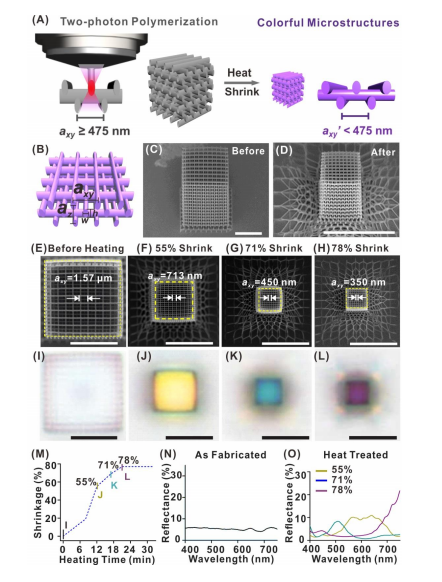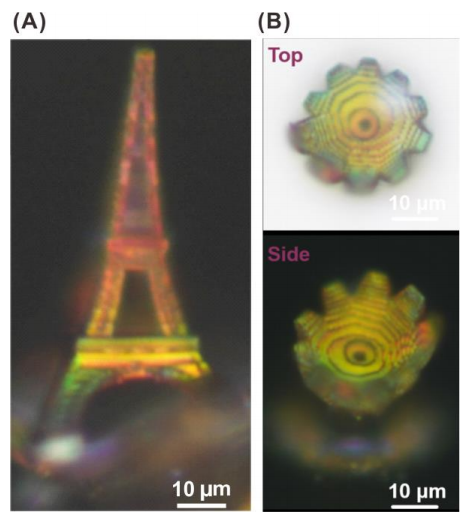In ‘Structural Color 3D Printing By Shrinking Photonic Crystals,’ international researchers explain that while inspiration may arise from nature, in displays of photonic crystals offering colorful patterns on everything from butterflies to weevils, it is still extremely challenging to 3D print color at the microscopic scale.
3D printing at the nanoscale is certainly a heavily-explored realm today, from experimentation with glass/ceramics to complex metal structures to scalable systems, but commercial printers are not yet able to create color of the type required for patterning photonic crystal structures ‘with the requisite ~300 nm lattice constant to achieve photonic stopbands/ bandgaps.’

Heat-shrinking induced colors of 3D printed woodpile photonic crystals. (A) Schematicof the fabrication process. Left: woodpile photonic crystal written in commercial IP-Dip resist by two-photon polymerization at dimensions well above the resolution limit of the printer to prevent
structures from collapsing. Right: after heat treatment, the dimensions of the photonic crystal are reduced below the resolution limit of the printer, and colors are generated. The colors change with different degrees of shrinkage. (B) Schematic showing 1 axial unit of the woodpile structure. axy and az denote the lateral and axial lattice constants, respectively. Tilted-view scanning electron micrographs (SEM) of a representative woodpile photonic crystal (C) before and (D) after heating. SEM images and corresponding bright field reflection-mode optical micrographs of the woodpile photonic crystal before heating (E,I) and with shrinkages of 55% (F,J), 71% (G,K) and 78% (H,L). (M) Shrinkage of the woodpile photonic crystal heated at ~450 °C as a function of heating duration. Reflectance spectra of the woodpile photonic crystal (N) before heating and (O) after heating with
55%, 71% and 78% shrinkage. Scale bars represent 10 μm
The researchers present a new method for fabrication of photonic crystals with a 5x reduction in lattice constants. With this technique, the researchers were able to 3D print microscopic objects, exemplified by their Eiffel Tower model, measuring only 39-µm tall with a color pixel size of 1.45 µm:
“To the best of our knowledge, this is the first demonstration of a full-color 3D printed object based on dielectric structural colors instead of dyes,” state the researchers, who foresee this technology as having potential also for applications in creating photonic optical devices and metasurfaces—to include circuits-on-a-chip, and other polarizers.
The heating process was beneficial in this technique in offering the proper amount of shrinkage for some of the structures (some samples failed, losing shape completely), along with altering the shape of the laser writing spot:
“The fabrication reliability and reproducibility for smaller structures is also improved as we can pattern mechanically robust structures within a larger process window. This concept is similar to that demonstrated in 2D with Shrinky Dinks, where structures printed using a simple desktop printer were later heat shrunk to micron length scales,” state the researchers.

Reflectance and bandstructure of a woodpile photonic crystal with axy = 350 nm, az = 614 nm. (A) Top view (top) and side view (bottom) reflection-mode optical micrographs of the woodpile photonic crystal. (B) Reflectance of the woodpile photonic crystal measured with topdown illumination (top) and side illumination (bottom). (C) First Brillouin zone and photonic bandstructure of the woodpile photonic crystal in the Γ-K and Γ-X directions. Stars indicate slow light modes and dots indicate stopbands. (D,E) Reflectance spectra and reflection-mode micrographs of woodpiles under top-down illumination conditions for axy = 300-350 nm (D) and axy = 350-672 nm (E), respectively. (F) Plot of reflectance-peak positions as a function of the lattice constant.
In 3D printing sample objects for the study, the research team fabricated numerous woodpile structures with a range of laser powers. Without heating, they were colorless, but after heating, the samples shrunk and became colorful.

3D Color Prints. (A) Composite optical micrographs of heat-treated woodpile photonic crystals with varying structural dimensions as viewed from the side. (B) Side illumination reflectance spectra of selected woodpile structures from (A). (C) GWL file used for lithographic printing of the Eiffel Tower, comprising of woodpile voxels. Micrographs of 3D printed model of the Eiffel Tower in structural blue (D) and structural red (E). (F) Oblique view of an Eiffel Tower printed with intentional gradient of colors. (G) Further down-scaled multi-color 3D print of the Eiffel Tower. (H) Optical micrograph and (I) SEM image of a 3D Chinese character “福” in structural red. (J) Close-up SEM image of dotted square region in (I). Scale bars in (A-I) represent 10 μm and scale bar in (J) represents 1 μm.
The Eiffel Tower sample shows off the ability to 3D printing both ‘arbitrary and complex’ objects microscopically, with lattice constants chosen by the researcher’s post-shrinkage.
“The tower was attached to the substrate at the tip and the fabricated 3D structures are observed from the side with an optical microscope,” state the researchers.
“The woodpile structures are structurally stable and can be used as building blocks for a variety of models. To demonstrate the versatility of the method, a 20 µm tall Chinese character for luck “福” was printed in structural red.”
The authors explain that objects can also be 3D printed in multiple colors, which they demonstrated not only with their print of the Eiffel Tower, but also the ArtScience Museum in Singapore.

Full-color models printed with heat induced shrinking method. Optical micrographs of models of the (A) Eiffel Tower and (B) ArtScience Museum in Singapore.
“The heat-induced shrinking method enables one to readily exceed the resolution limit of a 3D DLW system to print 3D objects that exhibit colors due to the underlying photonic bandstructures of the constituent lattices,” concluded the researchers. The good agreement between photonic bandstructure calculations and experimental results with no fitting parameters allows us to clearly identify slow light modes and stopbands as the source of spectral peaks, giving rise to a full range of colors.
“Our work demonstrates the ability to produce structural color within complex 3D objects at will and could be extended to developments in compact optical components and integrated 3D photonic circuitry that operate in the visible to NIR wavelengths.”
What do you think of this news? Let us know your thoughts! Join the discussion of this and other 3D printing topics at 3DPrintBoard.com.
Subscribe to Our Email Newsletter
Stay up-to-date on all the latest news from the 3D printing industry and receive information and offers from third party vendors.
You May Also Like
Gorilla Sports GE’s First 3D Printed Titanium Cast
How do you help a gorilla with a broken arm? Sounds like the start of a bad joke a zookeeper might tell, but it’s an actual dilemma recently faced by...
Nylon 3D Printed Parts Made More Functional with Coatings & Colors
Parts 3D printed from polyamide (PA, Nylon) 12 using powder bed fusion (PBF) are a mainstay in the additive manufacturing (AM) industry. While post-finishing processes have improved the porosity of...
$25M to Back Sintavia’s Largest Expansion of Metal 3D Printing Capacity Since 2019
Sintavia, the digital manufacturing company specializing in mission-critical parts for strategic sectors, announced a $25 million investment to increase its production capacity, the largest expansion to its operations since 2019....
Velo3D Initiates Public Offering in a Bid to Strengthen Financial Foundations and Drive Future Growth
Velo3D (NYSE: VLD) has been among a number of publicly traded 3D printing firms that have attempted to weather the current macroeconomic climate. After posting a challenging financial report for 2023,...































